By Beth MacBlane
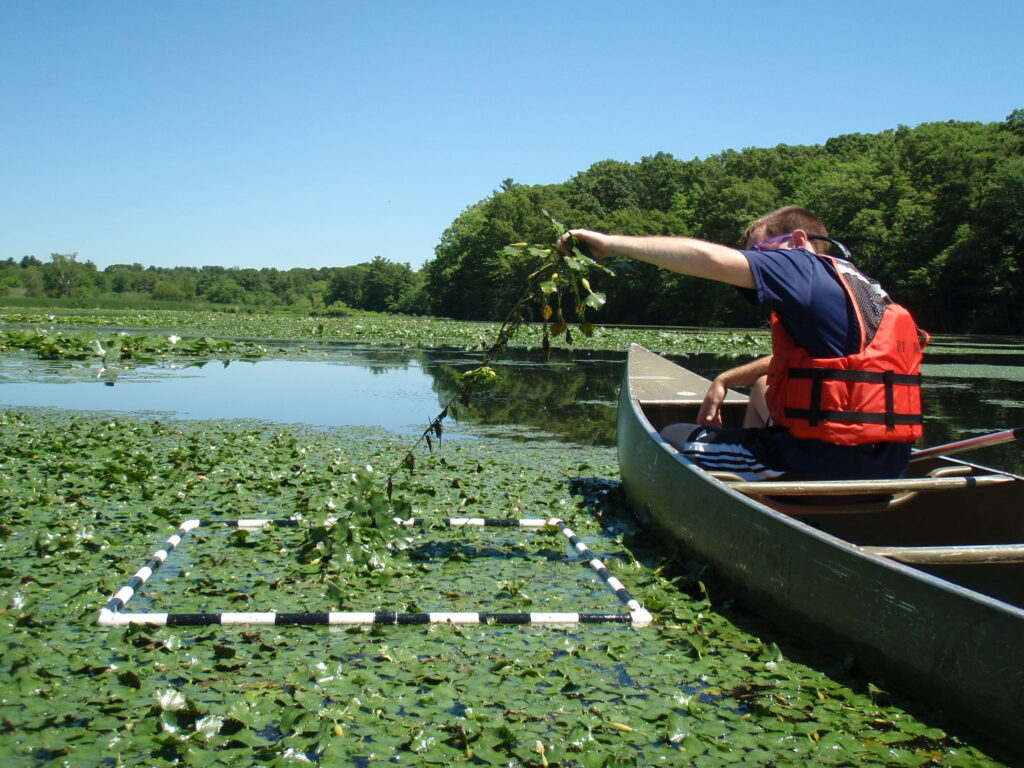
On a humid July morning before the sun peaks, a duo of paddlers push off the sandy shore of Lake Washington in Rhode Island, slowly gliding in their canoe toward the lily pads and grassy reeds in search of ecologically disruptive non-native plants. These seasonal water quality technicians, with the state’s Department of Environmental Management, travel to lakes and ponds over the course of the summer to survey for the presence or absence of the state’s 17 most common aquatic invasive plants. Their monitoring efforts have helped to assess the risks of the widespread problem of aquatic invasive species (AIS).
AIS are non-native plants, animals or other organisms that can cause harm to human health, the environment, and/or the economy. Invasive species are primarily spread to new ecosystems through human activities, often unintentionally, such as by boats traveling to a new waterbody with aquatic hitchhikers aboard.
Invasive species pose a major threat to both marine and freshwater environments across the globe. They can outcompete native species, decrease biodiversity, degrade water quality and habitat health, and disrupt the local food web. Recreational opportunities, such as swimming, boating and fishing, may be limited by AIS growth. From an economic standpoint, AIS can damage infrastructure, reduce waterfront property values and slow tourism due to decreased recreational opportunities.
Water resource professionals aim to reduce the risk of AIS by preventing their initial introduction to a waterbody. The first step is to monitor rivers, streams, lakes and ponds to understand what is already there through a baseline inventory of species present. Should an invader become an established population, there are several strategies to control the species, whether the goal is eradication, containment, reduction or maintenance to avoid uncontrolled growth.
“Lake Champlain is home to 51 known aquatic non-native and invasive species, and we know that many more could infest the lake via a number of pathways, including connected waterways,” said Meg Modley, NEIWPCC environmental analyst and aquatic invasive species management coordinator at the Lake Champlain Basin Program (LCBP). “These species, by design, are exceptional at overtaking new environments and in some cases, decimating native species. They are a huge threat to our aquatic ecosystems and a costly and challenging one to manage.”
The annual cost of invasive species prevention and management across the U.S. is estimated at $120 billion. Because humans often move AIS across state and international boundaries, a coordinated interstate – and often multi-agency – monitoring and management plan is frequently needed.
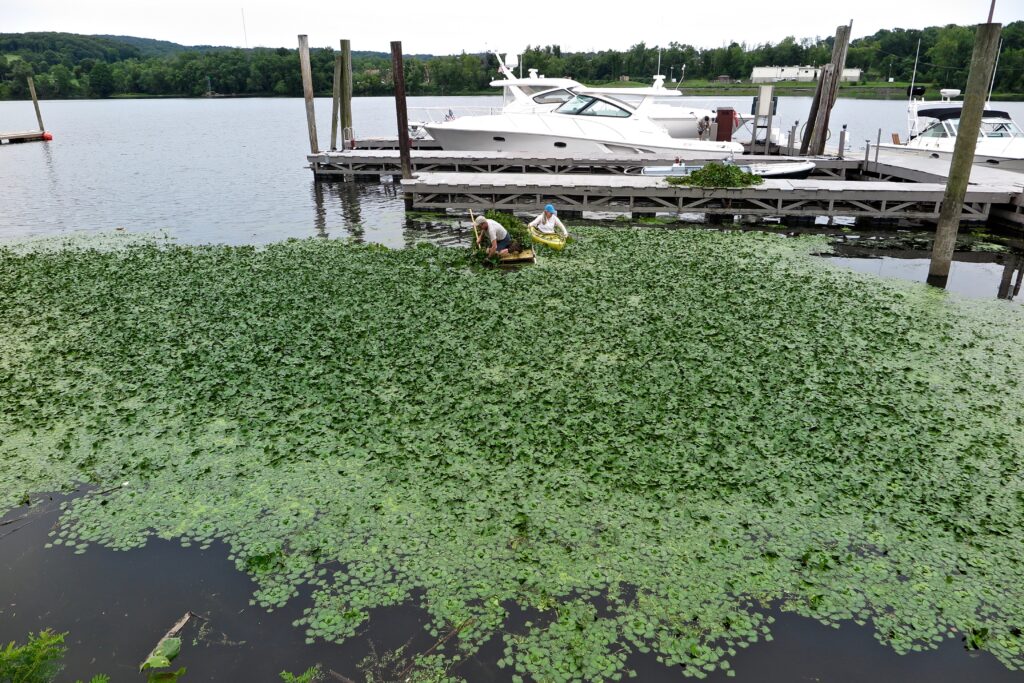
Management plans take into consideration the unique characteristics of the species at hand. This includes the growth rate, the success of control measures (such as herbicides), and the density and distribution of the population. Habitat is also a factor — the presence of sensitive areas, such as wetlands, threatened or endangered species, and adjacent land use can influence control strategies. Social and economic impacts, in addition to financial constraints, are also considered. Depending on these factors, the goal of a management plan may be to control the spread and limit the impact of the species rather than eradication.
“A challenge that is not unique to Rhode Island is having adequate resources available for AIS management,” said Katie DeGoosh-DiMarzio, an environmental analyst with the Rhode Island Department of Environmental Management. “We have over 88 ponds with variable-leaf milfoil, for example, and we can’t treat them all because we don’t have the resources to do so.”
AIS programs require a long-term approach, dedicated funding, and diligent staff to strategically address the issues. An infested area of water chestnut, for example, needs annual maintenance for 10 or more years as seeds can persist for more than a decade in the sediment. And, it comes at a cost: control at one 30-acre pond in Rhode Island was estimated at approximately $250,000 for the first five years. Another issue is the high demand for limited contractors who perform much of the management work in New England, such as herbicide application and mechanical harvesting. “A painful part of this work is prioritizing species management,” said Modley. “We can’t do it all, and in some cases, with the spiny waterflea for example, there is no effective management option – it’s all about containment and spread prevention.”
Despite the resource gap, managing invasive species is not an impossible feat. For example, the hydrilla plant has been successfully managed in the Crotan River in New York via herbicide treatment, watercraft inspections, public education and the restoration of a native plant called wild celery. Across the Northeast, state and federal agencies, watershed organizations, marinas and lake associations work to address the various invasive species plaguing and threatening to invade our waters, beginning with preventative measures. These aim to prevent favorable conditions for the AIS to establish itself, such as by curbing the human transport and spread of invasive species. This includes, for example, watercraft, trailer and equipment washing to avoid the overland transport of AIS to new waterways.
NEIWPCC staff work on various spread prevention strategies, from public outreach to regulation and policy. As part of the Lake Champlain AIS management plan, each summer boat launch stewards inspect watercraft launching and retrieving from public launches in both New York and Vermont. The surveillance is intended to intercept potential AIS and also provide education to the boaters on how best to protect the lake from these unwanted invaders, such as by draining boat bilges, motors, and livewells of all water before entering and after exiting the lake. In 2022 – the sixteenth season of the program – the stewards conducted 13,210 surveys for 13,629 watercraft and decontaminated 251 high-risk watercraft with high-pressure hotwater treatment, while speaking with 29,636 launch users about invasive species spread prevention measures.
Environmental agencies also use three other types of invasive species management strategies: mechanical, chemical and biological. Mechanical control methods include cutting or harvesting large infestations with machines; or hand-pulling, which is often best suited for small populations. Alternatively, agencies may opt for chemical methods to control the problem, applying federal and state approved herbicides, for example, to kill off the growth. Finally, organizations also employ biological control methods, which involves introducing species-specific predators from the AIS’s native habitat to reduce the invading population. This method requires extensive study, time and travel to identify suitable organisms.
Another strong deterrent in the spread of AIS has been establishing state laws and regulations surrounding the transportation, sale and distribution of baitfish and invasive species. Invasive species lists, rules and regulations vary from state to state, presenting an opportunity for increased state collaboration to prevent the spread of invasive species at a regional level. “A directive in the Rhode Island AIS Management Plan included review of current laws and regulations to identify gaps in our legislation,” said DeGoosh-DiMarzio. “We have since passed a law to prohibit the transport of invasive plants and are in the process of writing the regulations and policy to ban their sale.”
As Benjamin Franklin once said, “An ounce of prevention is worth a pound of cure,” and in the case of AIS, these words are especially true. Prevention measures are much less costly than controlling an invading species and eliminates ecological impacts as well.
This is illustrated through the efforts of NEIWPCC staff and state agency partners to curb the spread of three of the most aggressive species threatening the region: hydrilla, round goby and the zebra mussel.
Hydrilla
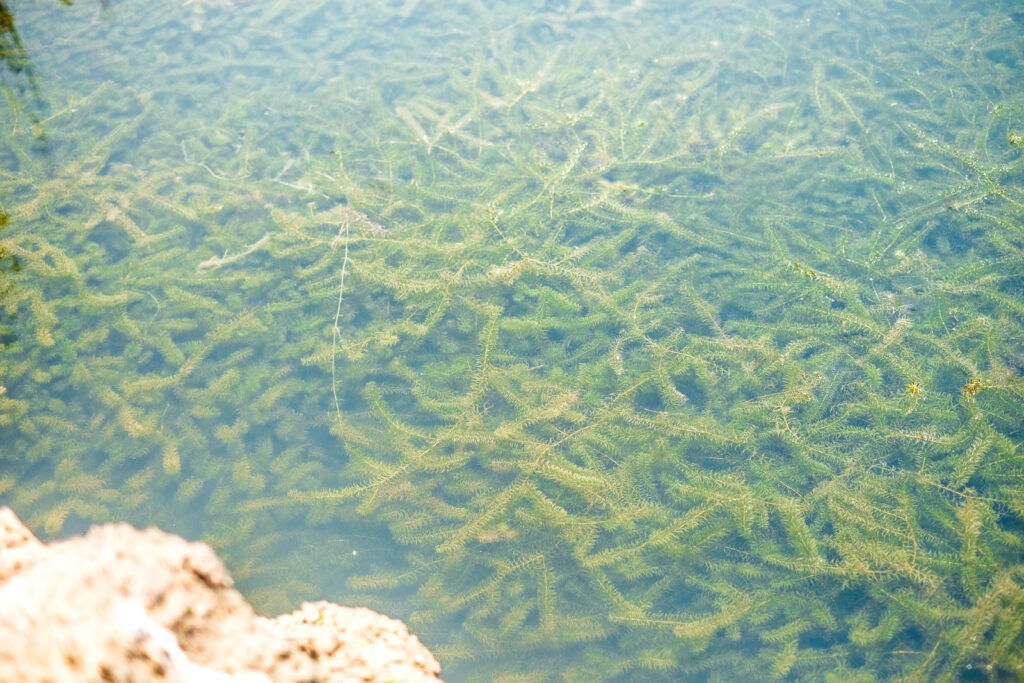
Dubbed the “almost perfect weed” by the U.S. Army Corps of Engineers, hydrilla (Hydrilla verticillata) is a submersed perennial plant native to Africa and Southeast Asia. It first appeared in the Connecticut River in Glastonbury, Connecticut in 2016.
In Florida and other parts of the country, this federally listed noxious weed grows in dense beds, causing significant economic and ecological impacts. These include shading out native plants, slowing water flow, clogging flood-control canals and pump stations, impeding swimming and boating and impairing fish habitat by altering water chemistry and lowering oxygen levels.
Accidental spread can occur when small hydrilla fragments hitchhike on watercraft, trailers and other recreational equipment, including in bait buckets and motors, and on draglines and anchors to new waterbodies. In the Connecticut River, it took only three years for hydrilla to spread, covering more than 774 acres after it was first detected.
A regional effort to address this unwanted species launched in 2017 during a Northeast Aquatic Nuisance Species Panel meeting. Starting in 2018 and 2019, aquatic plant surveys were conducted in Connecticut, Massachusetts, New Hampshire and Vermont to assess presence or absence, finding infestations as far north as Agawam, Massachusetts.
Currently, the United States Fish and Wildlife Service, United States Army Corps of Engineers, Northeast Aquatic Nuisance Species Panel, Connecticut River Conservancy, Connecticut Sea Grant, Lower Connecticut RiverValley Council of Governments, as well as the states of New York, Vermont, New Hampshire, Maine, Massachusetts, Connecticut and Rhode Island, and Canadian provinces are collaborating on the issue.
The Northeast Aquatic Nuisance Species Panel began the coordination for the Connecticut River Hydrilla Project, which published a five-year management plan in 2020. The plan reviews management options such as biocontrol, herbicides, harvesting, benthic barriers, watercraft inspections, and education and outreach. Also included are recommended best management practices for the watershed, relying heavily upon monitoring and adaptive management practices.
Round Goby
Native to Eurasia, the round goby (Neogobius melanostomus) is a small bottom-dwelling fish first found in the U.S. in Michigan’s St. Clair River in 1990. It was introduced by trans-Atlantic freight ships discharging ballast water – the water stored in a ship’s hull to provide stability. Now established throughout the Great Lakes, the round goby expanded its range via the canal system to the Hudson River, where it now poses a threat to the Lake Champlain ecosystem.
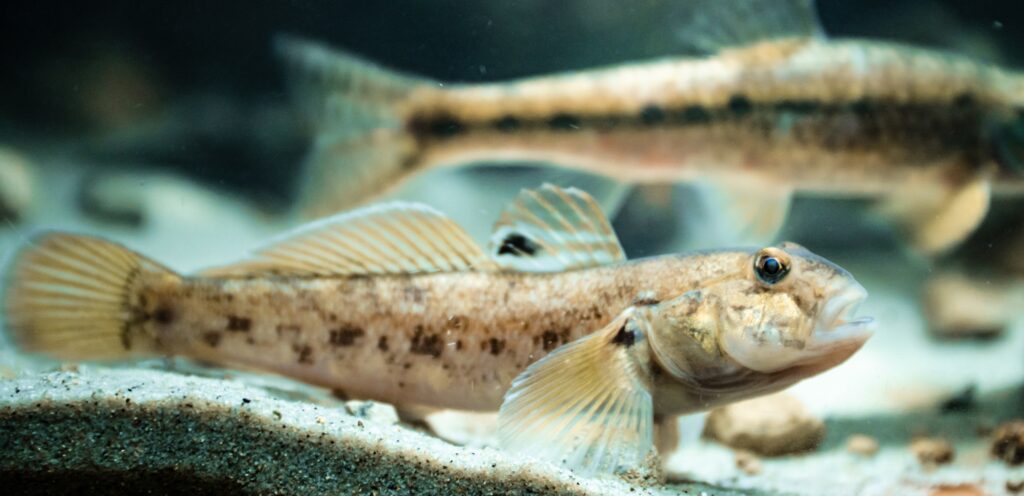
Round gobies outcompete native fish for food and habitat, resulting in decreased fish biodiversity. They prey on invertebrates, small fish and fish eggs, as well as zebra mussels. While devouring large amounts of invasive mollusks reduces the population, the zebra mussels contain toxins; therefore, consuming them poses a risk of bioaccumulation further up the food chain.
The recreational fishing industry stands to be impacted by the round goby as well. They are aggressive bait-taking fish and can change the angling experience by dominating bites on the line Gobies reproduce quickly and have voracious appetites – including for the eggs and fry of native bass and lake trout, both popular with anglers. Finally, they can also carry Viral Hemorrhagic Septicemia (VHS), a deadly fish disease affecting native species. While not yet present in Lake Champlain, VHS can affect over 25 species of freshwater fish.
A coordinated international response launched in 2021, following the U.S. Geological Survey (USGS) identification of gobies in the Champlain Canal of the Hudson River nearWaterford, New York. Farther north, gobies are established in the Richelieu River downstream of the Saint-Ours Dam in Quebec.
The LCBP’s AIS Rapid Response Task Force coordinated early detection monitoring and spread prevention education and outreach efforts with New York, Vermont and Quebec jurisdictions, including the USGS, U.S. Fish and Wildlife Service and Parcs Canada.
New York’s Canal Corporation and Department of Environmental Conservation (NYSDEC), with input from the Lake Champlain AIS Rapid Response Task Force, developed a Round Goby Rapid Response Plan. It outlines public education and outreach prevention strategies, as well as detailed early detection and response protocols based on specific scenarios.
2022 sampling results showed a slightly northward expansion of the gobies in the Hudson River. Intensive sampling will continue in 2023 and 2024 with U.S. and Canadian partners.
Monitoring efforts remain ongoing, and many state and federal agencies as well as nonprofits and community groups are working hard to spread the word about these harmful fish. NEIWPCC staff at the LCBP and NYSDEC continue to work with partner agencies on a coordinated response.
Zebra Mussels
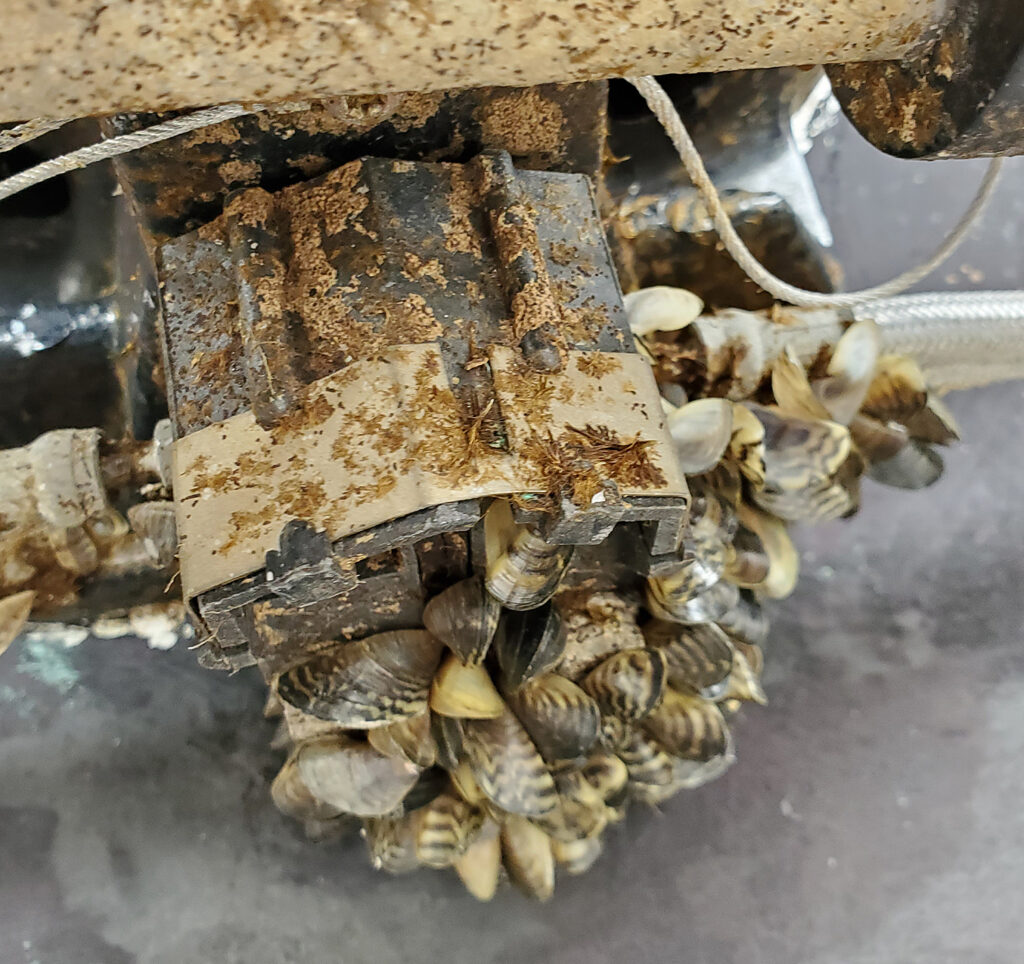
With black, zig-zag stripes, the aptly named zebra mussel (Dreissena polymorpha) is native to the Caspian and Black Seas of Eurasia. Likely transported via ballast water, they were first discovered in the U.S. in Michigan’s Lake St. Clair in the late 1980s. Since then, populations have expanded to the Northeast, from Lake Champlain, to East Twin Lake, Connecticut, to northern Maine, and in the Berkshire region of Massachusetts. Zebra mussels negatively impact ecosystems in a variety of ways.
They are filter feeders, efficiently siphoning plankton from the water and outcompeting native species. An increase in water clarity is commonly associated with their establishment, which impacts water quality and can enable submerged vegetation growth – including that of invasive plants. Zebra mussels attach themselves to native mussels, eventually incapacitating them and overtaking their habitat. Additionally, females mature at one year of age and can release up to one million eggs per year. This high reproductive rate enables the mollusk to quickly overwhelm a water body.
Zebra mussels are adapted to spread easily and, for humans, unknowingly. Microscopic freefloating larval stage mussels, known as veligers, float downstream to expand their range. Because they are invisible to the naked eye, humans can unintentionally transport infected water to other rivers or lakes, such as in bait bucket water and boat engine cooling water. To prevent such spread, it is essential to drain boats, motors and all tanks and wells before leaving a lake or river, and to wash and dry boats and trailers thoroughly. They are also transported by waterfowl and can attach to boat hulls.
Once established, the fingernail-sized bivalves are nearly impossible to remove. They secrete strong bundles of filaments, called byssal fibers, that allow them to securely attach to nearly any surface. Zebra mussels are known to encrust boats and docks, clog residential, municipal and industrial water intake pipes – including those at drinking water and power generation facilities – causing economic impacts. If left unchecked, they also corrode steel and concrete and deteriorate dock pilings. Additionally, shells may cover beaches and lake bottoms in infested areas, cutting the feet of recreational users.
No large-scale effective zebra mussel control exists to date, making prevention the key approach to their management. Public education and outreach campaigns aimed at stopping the spread depends on the efforts of boaters, anglers and other outdoor enthusiasts.
Stop the Spread
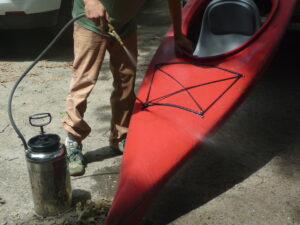
The Northeast is known for its rivers and lakes, and many are still free from invasive plants and animals. There are critical actions people can take to help prevent the spread and further impact of AIS:
- Clean, drain and dry all watercraft, trailers and fishing equipment to prevent the spread of aquatic hitchhikers.
- Dispose of unwanted bait, worms and fish parts in the trash.
- Don’t dump bait buckets into the water – follow local baitfish regulations.
- Do not move live fish (including baitfish) from one waterbody to another.
- Report all sightings of AIS to relevant agencies, such as the state fish and wildlife department.
- Become familiar with how to identify common AIS in the area.
- Don’t let it loose: do not dump aquarium pets into local waters.
This article was originally published in the Spring 2023 edition of Interstate Waters magazine. Beth MacBlane is an information officer in NEIWPCC’s Communications and Outreach Division.